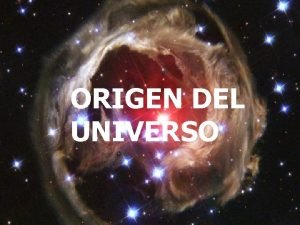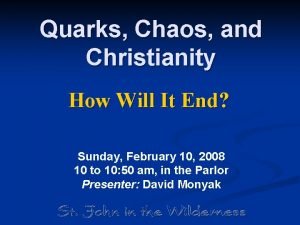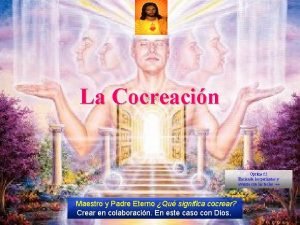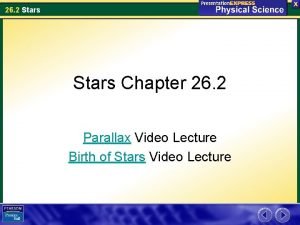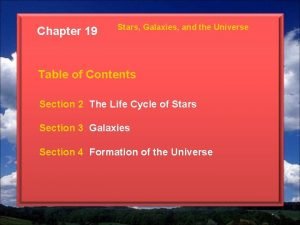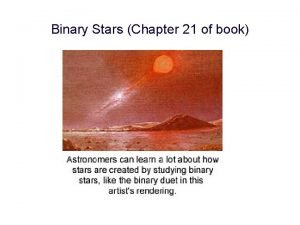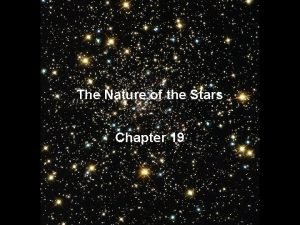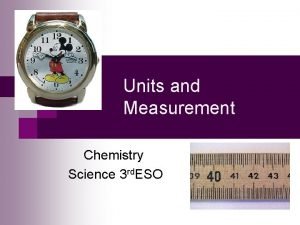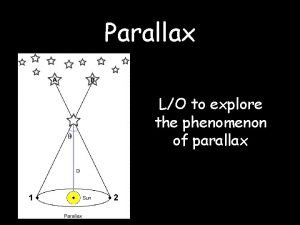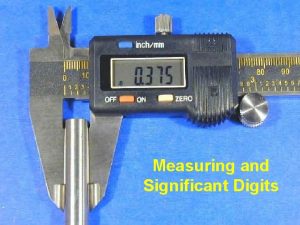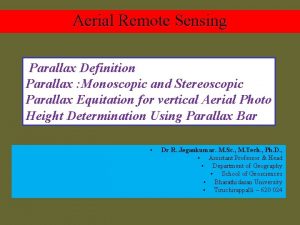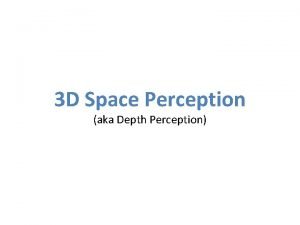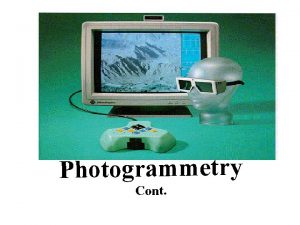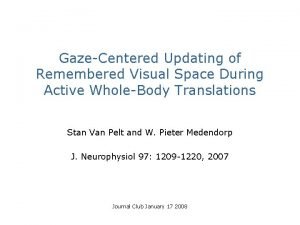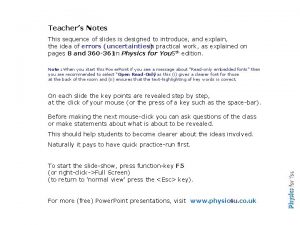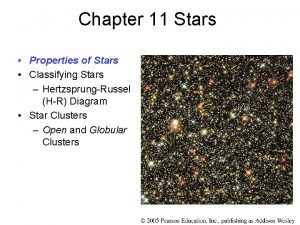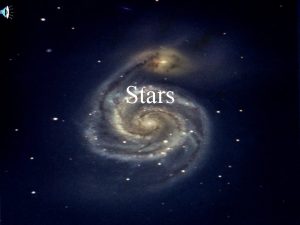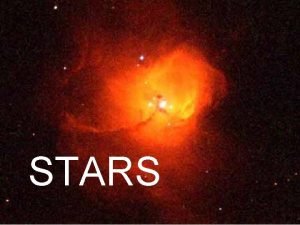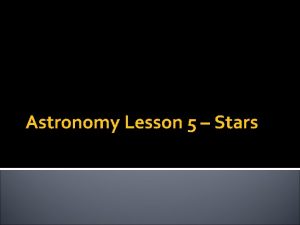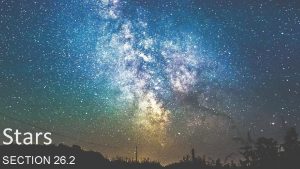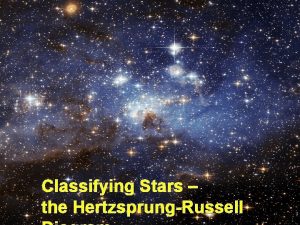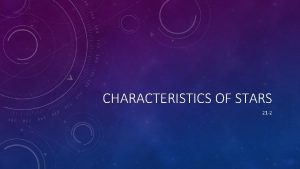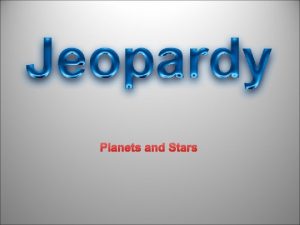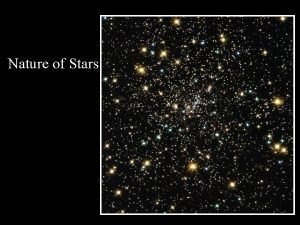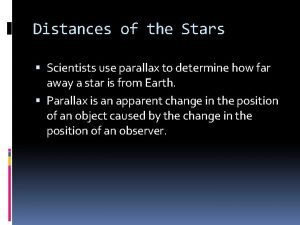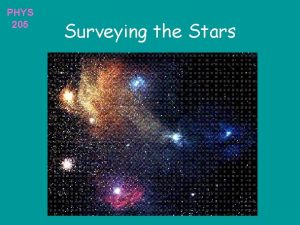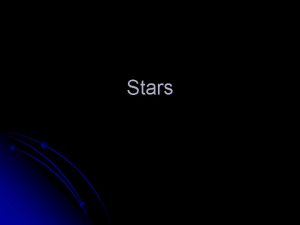Chapter 3 Crunch Time Parallax of Stars Parallax

























- Slides: 25

Chapter 3 Crunch Time

Parallax of Stars • Parallax is the apparent movement of a star when seen from a different position. Astronomers often use parallax to measure distances of nearby stars.

Parallax Challenge • Hold a finger about half an arm’s length away from your face. Switch back and forth between closing your left and right eye and watch how your finger appears to move against the background. – Why does your finger seem to move? – How does this relate to the parallax of stars?

Major Types of Galaxies


Spiral Galaxies • Galaxies that appear to have a bulge in the middle and arms that spiral outward like a pinwheel. • The arms contain gas, dust and many bright young stars. • Most new stars in spiral galaxies form in these arms. • The milky way galaxy in which we live is a spiral galaxy

Elliptical Galaxies • Look like round or flattened balls. • Contain billions of stars but have little gas and dust between the stars. • Because there is little gas or dust, stars are no longer forming. • Contain only old stars.

Irregular Galaxies • Do not have a regular shape. • Typically smaller than other galaxies • They generally have many bright, young stars and lots of gas and dust to form new stars.

Quasars • Active young galaxies with huge black holes at their centers. • Gas spins around the black hole, heats up and glows.

What keeps objects in orbit • Inertia: The tendency of an object to resist a change in motion. • The more mass and object has, the greater its inertia. An object with greater inertia is more difficult to start or stop.

• Newton concluded that inertia and gravity combine to keep Earth in orbit around the sun and the moon in orbit around Earth. Orbital Motion How would the moon move if Earth's mass increased?

Gravity and Motion • The strength of the force of gravity between two objects depends on the masses of the objects and the distances between them. • Inertia and gravity keep Earth in orbit. • Gravity helps form solar systems by bringing material together in a gradual build up.

How are stars classified • Stars are classified by their color, temperature, size, composition and brightness. • Chemical composition – Found with a spectrograph: a device that breaks light into colors or produces and image of the resulting spectrum.

• The brightness of a star depends on both its size and temperature. • The brightness of a star is described in two ways: apparent brightness and absolute brightness • Apparent brightness: how bright it appears as seen from Earth • Absolute Brightness: how bright the star would be if it were a standard distance from Earth.

Hertzprung-Russell diagram • The H-R diagram shows the relationship between surface temperature and absolute brightness of stars. • Astronomers use the H-R diagrams to classify stars and to understand how stars change over time.

Life cycle of stars • A star is born when the contracting gas and dust from a nebula becomes so dense and hot that nuclear fusion starts. • How long a star lives depends on its mass. • After a star runs out of fuel, it becomes a white dwarf, a neutron star, or a black hole.



Features of the sun you can see

Sunspots • Areas of gas on the sun’s surface that are cooler than the gases around them. • Cooler gases give off less light than hotter gases so they appear dark

Solar Flare • Occur when two sunspots connect. • A sudden burst of radiation from the sun. Most of the energy from a flare is ultraviolet light and X rays. • A solar flare may last several hours.

Solar Wind • Solar wind is made up of electrical particles from the sun. • Particles from the solar wind spread throughout the solar system. When they reach Earth, they interact with Earth’s magnetic field. • Cause auroras near the poles and magnetic storms.

Video Clips • 3 D sun • Journey to the stars • Death of the sun and stars

Review Questions • Why can’t astronomers measure the parallax of a star that is a million light-years away? • The tendency of an object to resist a change in motion is called _______. • An object is kept in orbit by _______ and ______. • There are two clouds of material; one with widely spaced objects with small masses and one with closely packed objects with larger masses. Which is more likely to form a solar system, the first or the second? Use gravity to explain your answer.

• How does a star’s mass indicate its lifetime? • In which part of the sun does nuclear fusion take place? • How can the solar wind affect life on Earth? • What are stars primarily composed of? • Suppose the force of gravity between Earth and the moon could be turned off. Describe the resulting change in the motion of the moon?
 There are millions of stars in the space
There are millions of stars in the space March madness dataset
March madness dataset Mapa conceptual de la galaxia
Mapa conceptual de la galaxia Game data crunch
Game data crunch John draper captain crunch
John draper captain crunch Quarks chaos and christianity
Quarks chaos and christianity Big crunch
Big crunch Elapsed time
Elapsed time Number the stars chapter 10 questions and answers
Number the stars chapter 10 questions and answers Between the stars chapter 26
Between the stars chapter 26 Number the stars vocabulary and questions answer key
Number the stars vocabulary and questions answer key Chapter 19 section 2 the life cycle of stars answer key
Chapter 19 section 2 the life cycle of stars answer key Binary star book
Binary star book The stars and i chapter 19
The stars and i chapter 19 Metric measures table
Metric measures table Parallax phenomenon
Parallax phenomenon Elimination of parallax
Elimination of parallax Define parallax error
Define parallax error Top pan balance zero error
Top pan balance zero error Greensock parallax
Greensock parallax Paralax enema
Paralax enema Parallax bar
Parallax bar Uncrossed disparity
Uncrossed disparity Parallactic angle in photogrammetry
Parallactic angle in photogrammetry What is motion parallax
What is motion parallax Parallax error random or systematic
Parallax error random or systematic


